The number of young adults entering treatment for heroin or crack is at its lowest recorded level, according to figures released by the NTA.
There was a 23 per cent fall in the number of 18 to 24-year-olds seeking treatment for heroin in the last year alone, to just over 4,000, says Drug treatment 2012: progress made, challenges ahead, and down from more than 11,000 seven years ago.
Of the total treatment population, nearly 30,000 people successfully completed their treatment in 2011-12, up nearly 2,000 from the previous year and three times the number from seven years ago, while the total number of people seeking heroin treatment for the first time has fallen to just over 9,000 from nearly 48,000 in 2005-06. Heroin remains the main problem drug, with over 96,000 of the total treatment population of 197,000 seeking treatment for heroin dependency, and 63,000 for heroin and crack. Powder cocaine accounted for just 5 per cent of the treatment population, and cannabis 8 per cent.
The current recession had not produced the same levels of youth unemployment as in the 1980s, said NTA chief executive Paul Hayes – although unemployment and hopelessness among the young remained ‘fertile territory for addiction’ – and combined with this had been the scale of investment in treatment over the last ten years, something that ‘cannot be guaranteed’ in the current climate. ‘There is a risk that squeezed local authorities will disinvest, not necessarily from treatment services, but from allied services that support recovery.’
The only age group whose numbers were increasing, however, were the over-40s, who now made up almost a third of the entire treatment population and represented a ‘particular challenge’, said Hayes. ‘Some became addicted in the heroin epidemics of the ’80s and ’90s and are only coming into treatment now, and many are at risk of death as their health fails.’ There were 802 drug misuse deaths among over-40s in 2011, says the report, 300 more than a decade ago and 500 more than among the under-30s.
Methadone remained ‘an absolutely crucial first step for many people’, Hayes stated, although too often in the past it had not been used as ‘a platform for recovery’. ‘The majority of, but not all, people with an opiate problem will pass through substitute medication, and it’s important that it’s available,’ he said. ‘But it’s also important that it doesn’t become a prop.’
The challenge was to deliver ‘a truly integrated, balanced and recovery-oriented system,’ said DrugScope chief executive Martin Barnes, something the treatment sector was capable of with the necessary resources and support. ‘In difficult economic times there is a strong and compelling case for national and local investment in drug and alcohol treatment,’ he said. ‘We need to continue to make this case as the local funding and commissioning environment is changing, with the election of police and crime commissioners, the introduction of the new public health system and the establishment of Public Health England. Despite encouraging trends in declining drug use, drug and alcohol dependency continue to blight the lives of many, with harms and costs for individuals, families and communities.’
Meanwhile, a private members’ bill to make lessons on drugs, alcohol and relationships compulsory in schools (see feature, page 10) has been introduced by Diana Johnson MP under the ‘ten minute rule bill’ procedure. The Relationship, Drug and Alcohol Education (Curriculum) Bill is backed by a range of organisations including Adfam, Mentor, Alcohol Concern and Turning Point.
Report at www.nta.nhs.uk


































Your Letters
We welcome your letters…
Please email them to claire@cjwellings.com or post them to The Editor, DDN Magazine, CJ Wellings Ltd, 57 High Street, Ashford TN24 8SG. Letters may be edited for space or clarity – please limit submissions to 350 words.
Letters
Be careful what you wish for…
At several conferences over the last few years, including at least twice at DDN service user involvement conferences, I have had the pleasure of hearing NTA chief executive Paul Hayes speak. At these events he has been challenged on why funding for drug treatment has been made available to tackle perceived drug related-crime, and several times faced impassioned pleas that drug use should be seen as a health issue, not dealt with by the criminal justice system. On each occasion Mr Hayes has agreed with the questioner, but urged them to take a pragmatic approach, pointing out the competition that budgets would face within a wider health and social care context.
I came across a ‘conference special issue’ of DDN from 2008 and Mr Hayes says: ‘Service users as a group are unpopular with the public, compared to old ladies who need hip replacements or babies in incubators. You are seen as the authors of your own misfortune – there is no way we can hide from that.’
Mr Hayes impressed on delegates that while the NTA was working to transform the negative image of drug service users and challenging attitudes towards them, its main business was to use criminal justice-led funding to improve treatment.